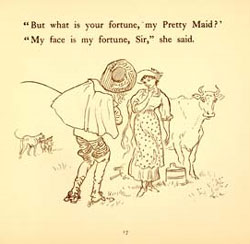Illustrators are not named and the author too is often anonymous. The publishers seem to be marketing series with a recognizable style and not their makers. Routledge's New Sixpenny Toy Books (11.3.5) ad on the back cover of one of the 106 titles available touts the beautiful color printing of Messrs. Leighton Brothers, Kronheim & Co., Vincent Brooks, Edmund Evans, and Dalziel Brothers, without mentioning their authors. Gradually a muddy book of little distinction about nine inches by twelve covered with ink and incident comes to be the industry standard. Kate Greenaway's and Randolph Caldecott's feel for white space and pictorial rhythm sets them apart. They soon were mentioned, along with Walter Crane and R. André (illustrator of Mrs. Ewing's books) in promotional material.
Kate Greenaway (whose books were exclusively printed by Edmund Evans, a pioneer of process color) is wild about hats. She can't resist decking out her young characters in elaborate headgear. This is partly why her children look like dwarf adults. In Under the Window (11.4.4), some naughty boys remark on it. "My eye! Three grannies out today." So much for wearing badminton shuttlecocks on their heads.
 Caldecott uses the cover to good effect in The Milkmaid (11.3.3). His airy single-color sketches provide contrast to the rampant patterns of the full-color pages. He has a feel for incidental comedy in his background drawings. A cow reacts to the maid's remark, "My face is my fortune, sir." A certain Timothy Blowhorn, Esquire (in R. Caldecott's Picture Book, 13.4.5) lies in the cemetery as the parson passes by on the hunt. Then follows a tag drawing of a fox on a horse chasing a man. Caldecott also has a feel for pathos. A lonely fiddler at the end of "Come Lasses and Lads" in the same book pokes at a discarded garland with his bow.
Caldecott uses the cover to good effect in The Milkmaid (11.3.3). His airy single-color sketches provide contrast to the rampant patterns of the full-color pages. He has a feel for incidental comedy in his background drawings. A cow reacts to the maid's remark, "My face is my fortune, sir." A certain Timothy Blowhorn, Esquire (in R. Caldecott's Picture Book, 13.4.5) lies in the cemetery as the parson passes by on the hunt. Then follows a tag drawing of a fox on a horse chasing a man. Caldecott also has a feel for pathos. A lonely fiddler at the end of "Come Lasses and Lads" in the same book pokes at a discarded garland with his bow.
Walter Crane has a bent for whimsical detail. His Three Bears (11.3.5) has Wedgwood plates saying Ursa Major, Ursa Minor, and Ursa Minimus, and a cowslip has a cow's head in A Masque of Flowers (6.1.1), 1889. Justin Schiller's census of the collection lists 18 books illustrated by Greenaway, and 46 illustrated by Caldecott and Crane.

